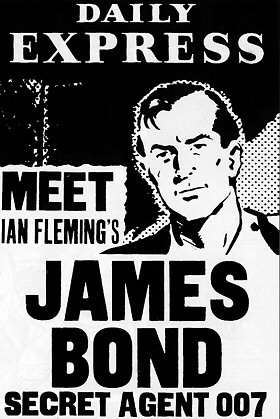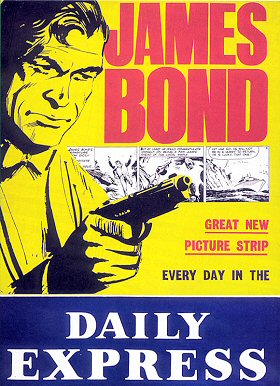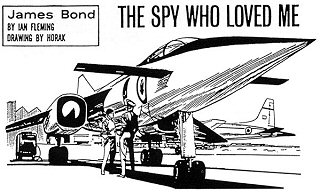 |
| |
MI6 looks back at the 25 year history of the 007's
newspaper comic strip adventures, which began with
"Casino Royale" in 1958...
|
|
History of 007's Newspaper Strips
15th September 2004
Four years before Sean Connery would bring 007 to the silver
screen with "Dr No", Daily Express readers in the UK got their
first sight of James Bond in 1958.
Although initially reluctant, Ian Fleming finally granted permission
to the London Daily Express to create a syndicated series of comic
strips based on his novels. Despite having been a journalist for
the Express himself, Fleming hesitated to accept the offer because
he was worried that his creation would devalue, and had concerns
about other writers transposing his stories to the new format.
|
"The Express are desperately anxious to turn James Bond
into a strip cartoon. I have grave doubts about the desirability
of this... Unless the standard of these books is maintained
they will lose their point and I think there I am in grave
danger that inflation will spoil not only the readership
but also become something of a death-watch beetle inside
the author. A tendency to write still further down might
result. The author would see this happening, and disgust
with the operation might creep in." - Ian Fleming, 1957
Edward Pickering, then editor of the Express, persuaded
Fleming that the comic strips would be a "Rolls Royce" of
a series with Anthony Herne to adapt the series, who had
previously serialised some of Fleming's novels for publication
in the Express.
Pickering also gave Fleming the final vote of approval
on the material before it would go for publication. Fleming
agreed to these terms and sold the rights of his novels
for syndication.
Right: Daily Express 1958 advertisement
preparing its readers for the introduction of James Bond
in "Casino Royale".
|
|
 |
Fleming's first James Bond novel "Casino Royale" would also become
the starting point for the newspaper series, with the first strip
published on July 7th 1958. Staff writer Anthony Hearne adapted
the novel, and John McLusky was brought in to illustrate.
 Above: The opening panel of "Casino
Royale"
Above: The opening panel of "Casino
Royale" |
Initially sticking closely to Fleming's source material, the
strips created by Hearne and McLusky were an instant success and
boosted sales of the newspaper. Fleming's concerns were eased
when the flow of the stories, although only read at a rate of
three cells a day, kept readers hooked despite losing a lot of
Fleming's detailed prose from the original material. The punchy,
fast-paced style and daily "cliff-hangers" suited Bond's adventures
perfectly.
 |
|
McLusky teamed up with writer Henry Gammidge for the following
seven years, recreating Fleming's novels and short stories
in the graphic form almost chronologically (except for a
one-off partnership of writer Peter O'Donnell with McLusky
for 1960's "Dr. No" adaptation).
Trouble broke out in 1962 however, when Fleming published
his short story "The Living Daylights" in rival newspaper
The Sunday Times. Express owner Lord Beaverbrook was angered
and abruptly curtailed the publication of the current strip
"Thunderball", which was only two months into syndication.
Kevin McClory, a thorn in the side of many future Bond productions,
also began his first legal action against Fleming for rights
on "Thunderball", which he co-wrote. Eventually a settlement
was bashed out between Fleming and McClory, allowing the
Express to continue publication of Fleming's other works
in 1964 - restarting with "On Her Majesty's Secret Service".
Left: Daily Express 1964 advertisement
celebrating the return of James Bond.
|
 Above: The opening panel of "On
Her Majesty's Secret Service"
Above: The opening panel of "On
Her Majesty's Secret Service" |
Thirteen adventures since the Express began publishing Bond strips
back in 1958, Gammidge and McLusky stepped aside for the new team
of Jim Lawrence and Yaroslav Horak as writer and artist respectively.
The new style had a harder edge, with Horak's sharp line art complimenting
Lawrence's creative work adapting the remaining, weaker, Fleming
material. 007's latest comic strip incarnation, starting with
"The Man With The Golden Gun" in 1966, broke away from the image
then synonymous with Sean Connery on the silver screen, as Bond
returned back to his cold-hearted, ruthless and dangerous roots.
 Above: The opening panel of "The
Man With The Golden Gun"
Above: The opening panel of "The
Man With The Golden Gun" |
|
The new team proved so popular with the Fleming Trust that
Lawrence and Horak were given the nod to add their own elements
to any existing Fleming material, and then continue with
their own - original - adventures. The duo would have 33
comic strip stories published in UK newspapers in all, along
with six adventures syndicated outside of the UK.
Right: "The Spy Who Loved Me"
was the last Fleming title to be adapted, first published
on December 18th 1967.
|
|
 |
In addition to these two long running partnerships, a one-off
pairing of writer Jim Lawrence with artist Henry North created
original story "Doomcrack" in 1981 for the Daily Star (part of
the Express newspaper group). Lawrence was then paired with original
007 strip artist John McLusky for a further four adventures for
the newspaper, and finally "The Scent of Danger " which was published
outside the UK. The dream team of Lawrence and Horak came back
for two final adventures ("Snake Goddess", "Double Edge"), again
unpublished in the UK.
Journey's end for James Bond in the UK serialised newspaper comic
strip format would come on 15th July 1983, upon the publication
of strip #673 of "Polestar" in the Daily Star (the story actually
ended on strip #719). In total, 45 adventures had been syndicated
in UK newspapers over the previous 25 years, with an additional
7 adventures published abroad. An amazing 6,500+ strips had been
produced between 1958 and 1983.
Today, James Bond's classic comic strip adventures are being
brought back to life by Titan Books, who began remastering and
republishing the stories starting with "The Man With The Golden
Gun" in February 2004.
Related Articles
 All Comics Articles
All Comics Articles